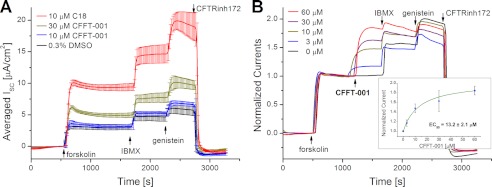FIGURE 3.
The dual-acting corrector-potentiator activity of CFFT-001. A, FRT cells stably expressing CFTR F508del were incubated for 24 h at 37 °C with either 0.3% DMSO, 10 or 30 μm CFFT-001, or 10 μm C18 before short circuit currents were recorded in Ussing chambers at 27 °C. The traces are base line-corrected averages of three individual recordings, except for the C18 positive control (n = 2). Error bars indicate the S.D. of the mean trace value. After a 20-min equilibration period and base-line acquisition, CFTR was activated maximally by additions of 10 μm forskolin, 100 μm IBMX, and 20 μm genistein prior to inhibition by 20 μm CFTR inhibitor 172 (CFTRinh172). Current increases due to CFFT-001 incubation are significant with p = 0.0059 (unpaired t test). B, current traces are averages of short circuit traces from cells that were incubated for 24 h with DMSO. Currents were normalized to the forskolin-elicited current (n = 3). After the forskolin-induced current stabilized, CFFT-001 was added to final concentrations of 0, 3, 10, 30, and 60 μm. Differences in the peak currents after all agonist additions, including 100 μm IBMX and 20 μm genistein, are not statistically significant. The inset shows the normalized current increases plotted against the corresponding dose of CFFT-001. Error bars are the S.D. of the mean current increases. The data were fitted with a Hill function (nH = 1, R2 = 0.996), which yielded an EC50 concentration of 13.2 ± 2.1 μm.

